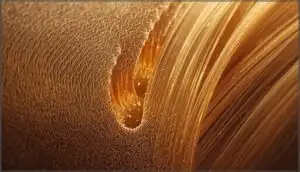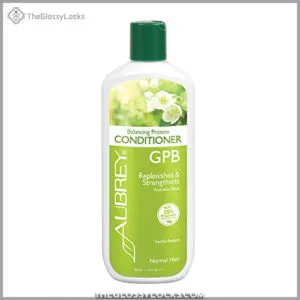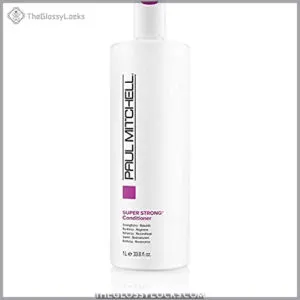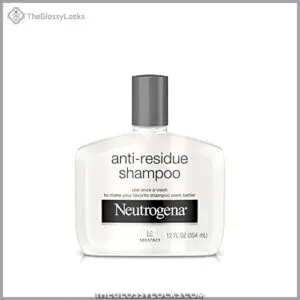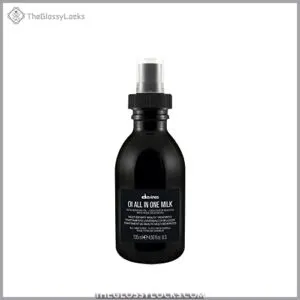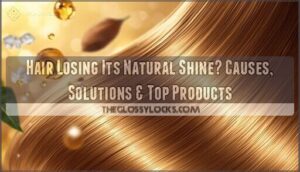This site is supported by our readers. We may earn a commission, at no cost to you, if you purchase through links.
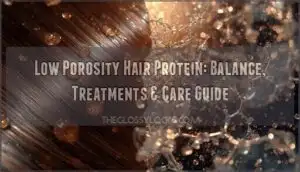
Your hair drinks water like a rain jacket repels it—and that’s exactly the puzzle of low porosity hair. The tightly sealed cuticle layer that keeps damage out also keeps moisture in limbo, which makes choosing the right protein treatments feel like walking a tightrope. Too much protein and your strands turn brittle and stiff. Too little and they lack strength and structure.
Understanding how low porosity hair protein works isn’t just about fixing bad hair days—it’s about breaking the cycle of product buildup, long drying times, and treatments that sit on your hair instead of sinking in. The key lies in molecular size, strategic timing, and knowing when your hair needs reinforcement versus hydration.
Table Of Contents
- Key Takeaways
- Characteristics of Low Porosity Hair
- How Protein Impacts Low Porosity Hair
- Balancing Protein and Moisture
- Best Protein Treatments for Low Porosity Hair
- 1. ApHogee Keratin Reconstructor Hair Treatment
- 2. Mielle Organics Babassu Mint Conditioner
- 3. Giovanni Xtreme Protein Hair Infusion
- 4. Aubrey GPB Natural Hair Conditioner
- 5. Paul Mitchell SuperStrong Strengthening Conditioner
- 6. Kinky Curly Moisturizing Sulfate Free Shampoo
- 7. Garnier Fructis Curl Nourish Shampoo
- 8. Neutrogena Clarifying Shampoo Anti Residue Cleanse
- 9. Davines OI All in One Milk
- 10. Jessicurl Deep Conditioning Treatment For Hair
- Optimizing Your Low Porosity Hair Routine
- Frequently Asked Questions (FAQs)
- Conclusion
Key Takeaways
- Low porosity hair has tightly sealed cuticles that resist moisture and protein absorption, requiring hydrolyzed proteins (smaller molecules) and heat application to penetrate effectively without causing buildup or overload.
- Protein treatments should be used sparingly—once every 4 to 6 weeks—with stiffness, brittleness, or straw-like texture signaling overload, while limp strands with excessive stretch indicate moisture deficiency.
- Clarifying every 2 to 4 weeks removes product buildup that blocks absorption, and deep conditioning with heat for 15 to 30 minutes temporarily opens cuticles so treatments can actually work.
- The right balance means choosing lightweight, hydrolyzed protein treatments followed immediately by moisturizing conditioners to prevent the dryness and breakage that come from either protein overload or moisture deficiency.
Characteristics of Low Porosity Hair
Low porosity hair is like a fortress—its tightly sealed cuticle layer makes it difficult for water and products to get inside.
Low porosity hair acts like a fortress, with tightly sealed cuticles that resist moisture and product absorption
This structure creates a unique set of challenges that affect everything from how your hair absorbs moisture to how it reacts to protein treatments.
Understanding what makes low porosity hair different will help you recognize it and care for it properly.
How Cuticle Structure Affects Protein Absorption
Your low porosity hair’s tightly packed cuticle layer creates a natural barrier that blocks protein absorption. These flat, sealed cuticles repel most protein molecules, causing them to sit on your hair’s surface rather than penetrating deeply.
That’s where hydrolyzed proteins make a difference—their smaller molecular size slips through those tight scales more effectively, especially when you apply heat to temporarily lift the cuticle layer. This hair type’s smooth cuticle layer makes it less able to absorb water.
Common Signs of Low Porosity Hair
You’ll notice several telltale signs of low porosity hair that set it apart. Your hair takes forever to dry after washing, often remaining damp for hours. Water beads up on the surface instead of soaking in—moisture repellence at its finest.
Product buildup happens quickly, leaving a greasy appearance despite using minimal amounts. One key indicator is that the cuticle layers lie flat, hindering moisture absorption.
Try the float test: drop a clean strand in water, and it’ll sit at the top.
Causes of Low Porosity Hair
Understanding what drives your hair’s porosity helps you care for it better. Several factors shape low porosity hair:
- Genetic Predisposition – Your DNA determines cuticle structure tightness, especially in straighter hair type characteristics.
- Lipid Integrity – The protective 18-MEA layer keeps hair hydrophobic.
- Chemical Damage – Bleaching and coloring strip natural barriers.
- Environmental Factors – UV exposure degrades proteins.
- Age-Related Changes – Natural lipid depletion affects moisture retention.
Cuticle structure matters most in determining hair porosity characteristics.
How Protein Impacts Low Porosity Hair
Protein plays a surprising role in how your low porosity hair behaves, and understanding this relationship can make or break your hair care routine. Your tightly closed cuticles change how protein interacts with your strands, which means what works for others mightn’t work for you.
Let’s look at how protein affects your hair health, what happens when you use too much, and which types actually penetrate those stubborn cuticles.
The Role of Protein in Hair Health
Your hair is built from keratin, a structural protein that gives each strand its strength and flexibility. Protein synthesis in your follicles assembles amino acids into keratin chains, maintaining hair health and growth.
For low porosity hair, protein fills damaged gaps in the cuticle, restoring structural integrity. Without adequate protein, you’ll notice increased breakage, thinning, and brittle strands, making protein’s role in hair care essential.
Protein Sensitivity and Overload Risks
When you overdo protein treatments, your hair rebels. Protein sensitivity makes strands feel stiff and straw-like, while protein overload blocks moisture from penetrating the tightly-packed cuticles.
Watch for these overload symptoms:
- Brittle texture that snaps instead of stretches, increasing breakage risks by up to 40%
- Elasticity loss causing hair to break rather than bounce back
- Moisture blockage leaving your hair chronically dry despite conditioning
Treating protein overload requires immediate clarifying and deep hydration. Avoiding protein overload means limiting treatments to once every 4-6 weeks.
Benefits of Hydrolyzed Proteins for Low Porosity Hair
Smaller molecules make all the difference. Hydrolyzed proteins like keratin and wheat protein slip past your tight cuticles where traditional proteins can’t reach, strengthening hair from within.
| Benefit | How It Helps Your Hair |
|---|---|
| Penetration Enhancement | Low molecular weight proteins cross the cuticle barrier where larger proteins fail |
| Breakage Reduction | Reinforced keratin structure cuts snapping and split ends noticeably |
| Moisture Retention | Proteins bind water molecules inside your strands, improving hydration balance |
These lightweight formulas won’t weigh you down or cause buildup. You’ll notice improved shine, better curl definition, and easier detangling after regular treatments every 4-6 weeks.
Balancing Protein and Moisture
Finding the sweet spot between protein and moisture is the key to healthy low porosity hair. Your hair sends clear signals when something’s off, whether it’s too much protein or not enough moisture.
Let’s break down how to recognize what your hair needs and get that balance just right.
Recognizing Protein Vs. Moisture Needs
Think of your hair like a recipe—too much of one ingredient throws everything off balance. Low porosity hair needs careful attention to both protein and moisture levels to stay healthy.
Here’s how to tell what your hair needs:
- Elasticity Testing – Gently stretch a wet strand; healthy hair bounces back, while brittle hair snaps (protein overload) or stretches too much (moisture deficiency)
- Texture Check – Dry, rough strands signal moisture deficiency, while stiff, hard hair indicates protein overload
- Product Buildup Assessment – Residue on your scalp can block moisture absorption, mimicking dryness
- Hair Brittleness Evaluation – Hair that breaks easily under slight pressure needs more moisture, less protein
- Response Monitoring – Track how your hair feels after treatments to adjust your protein-moisture ratio
Signs of Imbalance in Low Porosity Hair
When your hair feels off, it’s signaling an imbalance. Protein overload symptoms in low porosity hair create noticeable changes that demand attention.
| Protein Overload Signs | Moisture Deficiency Signs |
|---|---|
| Stiff, brittle hair that snaps easily | Limp strands with excessive stretch |
| Rough texture despite conditioning | Lack of elasticity and definition |
| Increased breakage at ends | Persistent dryness and dullness |
| Frizz texture with no curl pattern | Tangles that won’t resolve |
Stiffness and brittleness indicate too much protein blocking moisture penetration. Excessive dryness persists even after deep conditioning when protein creates barriers in the hair shaft. Loss of elasticity means strands can’t bend without breaking—a clear protein overload warning.
Tips for Achieving Optimal Protein-Moisture Balance
Balancing protein and moisture in low porosity hair starts with choosing hydrolyzed proteins—they penetrate tightly closed cuticles better than larger molecules. Apply heat during deep conditioning to temporarily open the cuticle for improved absorption.
Follow protein treatments with moisture replenishment using lightweight oils to seal hydration without heaviness.
Regular clarifying treatments prevent buildup that blocks both protein and moisture, helping you avoid protein overload while maintaining a healthy hair moisture balance.
Best Protein Treatments for Low Porosity Hair
Finding the right protein treatment for low porosity hair doesn’t have to be complicated. You need products with hydrolyzed proteins that can actually penetrate your tightly sealed cuticles without causing buildup.
Here are ten treatments that work well for low porosity hair types.
1. ApHogee Keratin Reconstructor Hair Treatment
ApHogee Keratin Reconstructor Hair Treatment offers a quick, two-minute protein boost specifically designed for damage repair without overwhelming low porosity hair. With hydrolyzed keratin protein, it penetrates your tightly closed cuticles more effectively than larger molecules.
You’ll want to use this weekly on wash days if your hair’s damaged, then space it out to every two to six weeks for maintenance. The key to avoiding protein overload is keeping application brief and always following with a moisturizing conditioner to maintain softness and prevent stiffness.
Best For: People with damaged, chemically treated, or low porosity hair who need a quick protein treatment to strengthen strands and reduce breakage without risking protein overload.
- Works in just 2 minutes, making it easy to fit into your wash day routine without adding much time.
- Contains hydrolyzed keratin that actually penetrates low porosity hair, plus moisturizing oils like avocado and jojoba to keep hair soft.
- Noticeably reduces breakage and improves hair strength after just a few uses, with many people seeing results within 4-5 applications.
- Can make your hair stiff and crunchy if you don’t follow up with a good moisturizing conditioner right after.
- Not great for protein-sensitive hair, and using it too often can actually cause dryness and more breakage.
- Contains parabens (methylparaben and propylparaben) if you’re trying to avoid those preservatives in your hair products.
2. Mielle Organics Babassu Mint Conditioner
Mielle Organics Babassu Mint Conditioner brings both protein and moisture to your low porosity hair through amino acids from wheat and soy. The lightweight babassu oil absorbs well without weighing down your strands, while peppermint oil soothes your scalp.
User experiences reveal this conditioner works best with heat application for deeper penetration. You’ll notice the strong mint scent profile during use, though it fades after rinsing.
It’s adaptable enough for weekly deep conditioning or as a quick treatment, balancing protein moisture needs without causing buildup on your tightly closed cuticles.
Best For: People with low porosity hair who need a lightweight conditioner that balances protein and moisture without causing buildup or weighing down their strands.
- Contains amino acids and babassu oil that penetrate well when used with heat, repairing damage while keeping hair light and manageable.
- Free from parabens, sulfates, and silicones, so it won’t create buildup on tightly closed cuticles that low porosity hair tends to have.
- Works as both a deep conditioner and quick treatment, giving you flexibility in how you use it based on your hair’s needs.
- The strong mint scent can be overwhelming for some users, even though it fades after rinsing.
- May need heat or longer application times to work effectively on low porosity hair, which adds extra steps to your routine.
- Some users report the container is small for the price, and occasional packaging issues like loose or unsealed caps have been mentioned.
3. Giovanni Xtreme Protein Hair Infusion
Giovanni Xtreme Protein Hair Infusion delivers hydrolyzed soy protein alongside shea butter and macadamia oil, creating a protein treatment that won’t overwhelm your low porosity hair. You’ll massage this creamy formula into freshly shampooed hair and leave it for 3 to 10 minutes before rinsing.
User experiences show it softens and detangles without heavy buildup when applied correctly. The key is monitoring how often you use it—weekly application works for some, while others need it less frequently to avoid protein overload and maintain that protein-moisture balance your hair craves.
Best For: Those with low porosity, damaged, or overprocessed hair who need a protein treatment that strengthens without causing buildup or weighing hair down.
- Hydrolyzed soy protein penetrates easily into low porosity hair, strengthening strands without the heaviness of larger protein molecules.
- The blend of shea butter and macadamia oil balances protein with moisture, helping you avoid that stiff, dry feeling protein overload can cause.
- Works quickly in just 3 to 10 minutes, making it easy to fit into your wash day routine without a long wait time.
- You’ll need to watch how often you use it since too much protein can make low porosity hair feel dry or stiff over time.
- The dimethicone in the formula might build up on some hair types if you don’t clarify regularly.
- Results vary quite a bit depending on your specific hair needs, so finding the right frequency takes some trial and error.
4. Aubrey GPB Natural Hair Conditioner
Aubrey GPB Natural Hair Conditioner combines glycoprotein and milk protein with organic aloe vera and shea butter, giving your low porosity hair a gentle protein boost without the stiffness.
You’ll apply it to damp hair for 1-2 minutes as a regular conditioner, or leave it on dry hair for 15 minutes when you need deeper treatment.
User experiences highlight reduced breakage and improved manageability at around $10 per bottle. The light protein concentration prevents overload while strengthening your strands, though you might want to follow with a moisturizing conditioner to maintain balance.
Best For: People with low porosity or damaged hair who need a light protein treatment to strengthen strands without weighing them down or causing stiffness.
- Balances protein and moisture with glycoprotein, milk protein, and organic aloe vera to reduce breakage and improve manageability without overloading hair.
- Affordable at around $10 per bottle with a vegan, organic formula that’s free from harsh sulfates and parabens.
- Versatile application—use as a quick 1-2 minute conditioner or leave on for 15 minutes as a deep treatment depending on your hair’s needs.
- Some users find the texture pasty and the herbal scent medicinal or off-putting compared to more fragrant conditioners.
- May not provide enough moisture on its own for very dry hair, often requiring a follow-up moisturizing conditioner to maintain balance.
- Formula changes over time and occasional stock shortages have led some longtime users to report inconsistent quality and effectiveness.
5. Paul Mitchell SuperStrong Strengthening Conditioner
Paul Mitchell SuperStrong Strengthening Conditioner offers your low porosity hair hydrolyzed vegetable protein that penetrates better than larger molecules. Key ingredients like canola oil and cornstarch add moisture alongside that protein boost, balancing strength with softness.
User experience shows improved manageability without heaviness, though you’ll want to leave it on for 15–45 minutes for best absorption through those tightly sealed cuticles. The safety profile includes a paraben-free and vegan formulation.
Watch for protein overload signs if you’re using other protein treatments regularly—balance matters more than frequency.
Best For: People with low porosity or damaged hair who need a protein-based strengthening conditioner that won’t weigh hair down, especially if you’re willing to leave it on longer for better absorption.
- Contains hydrolyzed vegetable protein that actually penetrates low porosity hair when you give it enough time (15–45 minutes works best).
- Balances strengthening protein with moisturizing ingredients like canola oil and cornstarch, so hair doesn’t end up feeling stiff or straw-like.
- Lightweight formula that won’t cause buildup or greasiness, plus it’s paraben-free, vegan, and safe for color-treated hair.
- Needs a longer processing time than most conditioners to work properly on low porosity hair, which isn’t always convenient.
- Can cause protein overload if you’re already using other protein treatments, making hair feel dry or brittle instead of stronger.
- At $41, it’s pricier than drugstore options, and you might need to order online since it’s not always available in stores.
6. Kinky Curly Moisturizing Sulfate Free Shampoo
Sulfate-free benefits start with understanding that harsh cleansers damage your cuticle layer. Kinky Curly Moisturizing Sulfate Free Shampoo uses phytic acid for buildup removal without stripping natural oils, making it ideal for low porosity hair that already struggles with moisture balance.
You get gentle cleansing from coconut-derived surfactants plus mandarin orange extract. The protein-free formula prevents overload while organic sea kelp maintains hydration.
At $14.99, this shampoo removes hard water minerals effectively, though daily use might dry thicker textures. Ingredient safety ranks high—vegan, paraben-free, and color-safe for your hair care routine.
Best For: People with low porosity, dry, or damaged hair who need a gentle clarifying shampoo that removes buildup without causing protein overload or stripping natural moisture.
- Uses phytic acid to effectively remove hard water minerals and product buildup without harsh sulfates that can damage your hair cuticle.
- Protein-free formula prevents overload in low porosity hair while organic sea kelp and mandarin orange extract maintain moisture balance during cleansing.
- Vegan, cruelty-free, and color-safe with no parabens or synthetic fragrances, making it suitable for sensitive scalps and chemically treated hair.
- Can be too stripping for thick hair types and may cause dryness if used too frequently as a daily shampoo.
- Requires follow-up with a moisturizing conditioner or leave-in treatment to maintain optimal hydration, especially for very dry hair.
- Not ideal for hair types that need intense moisture since it’s formulated as a clarifying product meant for occasional or moderate use.
7. Garnier Fructis Curl Nourish Shampoo
At $3.99, you’re getting plant protein and coconut oil designed for curly hair without sulfates or parabens. Garnier Fructis Curl Nourish Shampoo uses hydroxypropyltrimonium lemon protein—a hydrolyzed form small enough to penetrate your tightly-closed cuticles for curl definition.
Low porosity hair benefits from this moisture balance approach, though consumer reviews note occasional buildup requiring clarifying shampoo rotation.
The formula’s glycerin and coconut oil support hydration alongside protein ingredients, offering affordable nourishment for hair products targeting frizz reduction over 48 hours.
Best For: People with low porosity curly hair looking for an affordable, protein-enriched shampoo that balances moisture without weighing down curls.
- Contains hydrolyzed lemon protein that’s small enough to penetrate low porosity hair, plus coconut oil and glycerin for hydration.
- Sulfate-free and paraben-free formula cleanses gently without stripping natural oils your hair needs.
- At $3.99, it’s budget-friendly compared to other curl-specific shampoos while still delivering frizz control for up to 48 hours.
- Some users report product buildup over time, meaning you’ll need to rotate in a clarifying shampoo occasionally.
- The hydrating properties might feel too heavy for people with oily scalps or fine curly hair.
- Not everyone sees dramatic results compared to other drugstore options, so performance varies by hair type.
8. Neutrogena Clarifying Shampoo Anti Residue Cleanse
For $297.99, this 12-ounce bottle removes up to 90% of product buildup—a critical clarifying benefit for low porosity hair prone to residue accumulation. Neutrogena’s clarifying shampoo contains no protein ingredients, making it ideal for your clarifying hair routine without contributing to protein overload.
Consumer reviews rate it 4.6 stars for effective residue removal, though you’ll need a moisturizing follow-up since strong surfactants can dry hair.
Use weekly to clarify hair before protein treatments, helping your tightly-closed cuticles absorb products more effectively.
Best For: People with low porosity hair who need a weekly clarifying treatment to remove product buildup without adding protein, especially before deep conditioning or protein treatments.
- Removes up to 90% of residue from styling products, conditioners, and shampoos in one use, which helps low porosity hair absorb moisture better.
- Contains no protein ingredients, so it won’t contribute to protein overload on hair that’s already protein-sensitive.
- Works on all hair types including color-treated hair, with a 4.6-star rating from over 1,100 customer reviews.
- Strong cleansing surfactants can leave hair feeling dry or stripped, so you’ll need a good moisturizing conditioner afterward.
- Should only be used once weekly since overuse can make hair brittle or overly dry, especially on sensitive low porosity hair.
- The price of $297.99 for a 12-ounce bottle is extremely high compared to typical clarifying shampoos.
9. Davines OI All in One Milk
While Davines OI All in One Milk isn’t technically a protein treatment, it’s a lightweight leave-in conditioner that works well alongside your protein routine for low porosity hair. At $45 for 4.6 ounces, you’ll get heat protection up to 230°C and frizz control efficacy powered by roucou oil benefits—beta-carotene and antioxidants that protect without protein overload.
Its scent profile analysis reveals aromatic thyme and musk notes. The lightweight hydration formula absorbs quickly, making it ideal for sealing in hair moisture after clarifying treatments without heavy buildup.
Best For: Anyone with dry, frizzy, or fine hair looking for a lightweight, vegan leave-in that detangles, adds shine, and protects against heat.
- Smooths frizz and softens hair without weighing it down
- Offers heat protection up to 230°C and quick absorption
- Vegan formula with natural antioxidants and a pleasant, long-lasting scent
- Pricey for the size at $45 for 4.6 ounces
- Scent may be strong for sensitive users
- Not a true protein treatment; mainly focuses on hydration and detangling
10. Jessicurl Deep Conditioning Treatment For Hair
Ever wondered why your low porosity hair feels thirsty but heavy after treatments? Jessicurl Deep Conditioning Treatment delivers protein-free benefits, letting you hydrate without risking overload.
Its vegan formulation—packed with shea butter and cocoa butter—offers deep conditioning that won’t weigh down fine strands. User experiences highlight better curl definition and less frizz, especially when heat application helps ingredients absorb.
Ingredient analysis shows no added protein, making it ideal for protein-sensitive hair. For low porosity hair, this hair treatment brings moisture and manageability.
Best For: People with dry, low porosity, or protein-sensitive curly hair who want a vegan, deeply moisturizing conditioner without added protein.
- Hydrates and softens curls without weighing hair down
- Protein-free formula is safe for sensitive or low porosity hair
- Vegan, cruelty-free, and suitable for color-treated hair
- May feel too thick or heavy for some hair types
- Requires 30–60 minutes for best results, which can be time-consuming
- Might not be moisturizing enough for extremely dry hair
Optimizing Your Low Porosity Hair Routine
Getting the best out of low porosity hair means choosing the right steps and products for your routine. You’ll want to focus on methods that help your hair absorb what it really needs.
Here’s how you can fine-tune your care for healthier, stronger strands.
Clarifying and Product Buildup Prevention
Did you know hair product buildup can mask your hair’s true porosity? For low porosity hair, clarifying frequency is key—think every 2–4 weeks. Watch out for buildup ingredients like silicones, and stick to gentle clarifiers for scalp health.
Here’s what works:
- Use sulfate-free shampoos
- Try apple cider vinegar rinses
- Avoid heavy, oily products
Deep Conditioning With Heat for Better Absorption
Once buildup is out of the way, heat application steps in to help deep conditioning work its magic. Well-judged temperature and ideal duration—15 to 30 minutes—open cuticles for better product penetration and hair moisture absorption. Protective measures like moderate heat and caps reduce risks. That’s how you turn low porosity hair’s resistance into real softness and strength.
| Heat Application | Ideal Duration | Protective Measures |
|---|---|---|
| Opens cuticle | 15–30 minutes | Heat caps |
| Boosts moisture | Weekly | Warm towels |
| Absorbs product | Not excessive | Hooded dryer |
| Reduces dryness | Monitored time | Steam treatments |
| Strengthens hair | Consistent use | Temperature control |
Choosing Lightweight, Protein-Free Moisturizers
After opening your cuticles with heat, lightweight products seal in that moisture without weighing you down. Protein-free moisturizers prevent stiffness and buildup while improving absorption rates and hydration balance.
Look for these three essentials when selecting hair products for low porosity hair:
- Humectants like glycerin or aloe vera that draw moisture into the shaft
- Light oils such as jojoba or babassu for easy penetration
- Zero keratin, silk, or collagen proteins to avoid overload and maintain product efficacy
Frequency and Application of Protein Treatments
Protein treatments are most effective for low porosity hair when applied once every 4 to 6 weeks. This schedule helps prevent protein overload while maintaining strong strands. To apply, start with damp hair, use heat for 20-30 minutes to open the cuticles, and then rinse with cool water.
| Timing | Application Method |
|---|---|
| Every 4-6 weeks | Apply on damp, clarified hair |
| Use moderate heat | Hooded dryer or warm towel for 20-30 minutes |
| Follow with moisture | Deep condition immediately after rinsing |
Be mindful of signs of protein overload, such as stiffness, brittleness, or a straw-like texture. If your hair feels strong but dry, consider increasing moisturizing treatments and extending the interval between protein treatments to 6 weeks or longer. Scientific studies show that hydrolyzed proteins penetrate better and can reduce breakage by up to 50% when properly balanced with moisture.
Frequently Asked Questions (FAQs)
Can low porosity hair ever change over time?
Yes, your hair porosity can shift over time. Damage accumulation from chemical treatments, heat styling, and environmental factors gradually raises porosity by weakening cuticles, while age-related changes also affect how your hair absorbs moisture.
Are DIY protein treatments safe for low porosity?
They’re generally safe when used correctly, but low porosity hair care requires careful attention.
Hydrolyzed benefits shine through smaller molecules that penetrate better, while safe application and mitigating side-effects prevent protein overload and hair damage.
How does chlorine exposure impact low porosity hair?
Chlorine absorption damages the cuticle and causes protein depletion, even in low porosity hair. You’ll notice hair dryness, breakage, and sometimes color changes.
It also triggers scalp irritation while compromising your hair’s natural protective barrier.
Should children with low porosity use protein treatments?
Children with low porosity hair can use protein treatments, but cautiously. Their delicate strands need hydrolyzed proteins applied sparingly—once monthly maximum—to avoid overload risks while maintaining moisture balance through proper hair care.
Conclusion
You can’t have your cake and eat it too—but with low porosity hair protein, you can get close. The right balance means your strands stay strong without turning stiff, and hydrated without feeling heavy.
Choose hydrolyzed proteins, clarify regularly, and use heat when deep conditioning. Your hair’s tight cuticle structure isn’t a flaw—it’s just a lock that needs the right key.
Master the balance, and you’ll finally realize your hair’s full potential.
- https://www.healthline.com/health/low-porosity-hair
- https://www.sciencedirect.com/topics/materials-science/keratin
- https://patternbeauty.com/blogs/news/low-porosity-hair-routine
- https://mielleorganics.com/blogs/texture-toolkit/10-low-porosity-hair-care-tips
- https://ethique.com/blogs/hair/what-is-clarifying-shampoo

